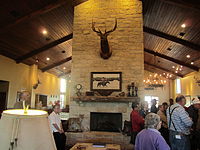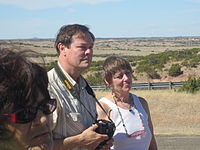- Matador Ranch
-
Cottonwood Mott Line Camp, originally part of the Scottish owned Matador Land & Cattle Company, is now privately owned by Mott Creek Ranch. It was the site of two gunfights in the early days. Motley County, Texas
 File:Kitchen, Mott Creek Ranch, Motley County, TX IMG 1539.JPGKitchen at Cottonwood Mott Line Camp, Mott Creek RanchFile:Bedroom, Mott Creek Ranch, Motley County, TX IMG 1536.JPGBedroom at Cottonwood Mott Line Camp, Mott Creek RanchFile:Horse at Cottonwood Mott Line Camp, Mott Creek Ranch, Motley County, TX IMG 1533.JPGA lone horse grazing at the Mott Creek Ranch, originally part of the historic Matador Land & Cattle Company, owned by a Scottish syndicate
File:Kitchen, Mott Creek Ranch, Motley County, TX IMG 1539.JPGKitchen at Cottonwood Mott Line Camp, Mott Creek RanchFile:Bedroom, Mott Creek Ranch, Motley County, TX IMG 1536.JPGBedroom at Cottonwood Mott Line Camp, Mott Creek RanchFile:Horse at Cottonwood Mott Line Camp, Mott Creek Ranch, Motley County, TX IMG 1533.JPGA lone horse grazing at the Mott Creek Ranch, originally part of the historic Matador Land & Cattle Company, owned by a Scottish syndicateThe Matador Ranch is an historic cattle ranch and hunting operation in Motley County, Texas, on the South Plains. Established in 1882, the Matador is located some ninety miles east of Lubbock. According to its website, the current mission of the ranch is improvement of the health and productivity of its livestock, wildlife, and renewable natural resources. The ranch also has a wildlife habitat management program, a guest lodge, and a deer breeding program which utilizes industry-recognized genetics.[1]
Contents
Background
Henry Harrison "Hank" Campbell (1840–1911), a native of North Carolina, arrived in Texas in 1854, prior to his service in the Confederate Army and his subsequent work as a cattle drover. In 1879, with four other investors, Campbell launched what became the Matador Ranch based about Ballard Springs. Campbell's wife, the former Elizabeth Bundy, joined him in Motley County in 1880. Rather than accepting life in a dugout as was then customary, Mrs. Campbell insisted on tent camping until lumber could be arranged for a two-room house. She was nurse and hostess at the ranch and the postmistress at the nearby town of Matador.[2]
In the beginning, the Matador grew to encompass 40,000 head of cattle on 100,000 acres (400 km2) of land and another 1,500,000 acres (6,100 km2) of open range rights. In 1882, the ranch was purchased by a syndicate from Scotland, the Matador Land and Cattle Company, Ltd. Campbell continued as the ranch superintendent until 1891.[2] The Matador Ranch acquired the Cottonwood Mott, named for a stand of trees surrounding a nearby natural spring. Cowboys used the camp as a base from which to herd cattle and mend fences on the range. A log cabin built at the camp by employees of the Jingle Bob Ranch, was the site of at least two gunfights.[3]
The ranch at its peak
In its heyday in the early 20th century, The Matador extended from Motley into neighboring Cottle, Dickens, and Floyd counties. In 1902, the ranch also acquired the 210,000-acre (850 km2) Alamositas Ranch in Oldham County west of Amarillo. Additional pastures were leased in North Dakota, South Dakota, Montana, and Canada. At its peak, the Matador Ranch owned 90,000 cattle and had title to 879,000 acres (3,560 km2) of land in parts of four Texas counties.[4] In 1913, the Quanah, Acme and Pacific Railway was built through ranch lands in Motley County, and the town of Roaring Springs was established.[4]
The general manager of the ranch operated from, first, Fort Worth, Texas, and later Trinidad and Denver, Colorado. The last of the general managers was John Mackenzie, who served from 1937 until the ranch was liquidated in 1951. The last of the on-site ranch managers was John V. Stevens, active from 1941-1951. Corporate offices were maintained in Scotland from 1882 until 1951. The ranch was purchased by Koch Industries, Inc., and a portion of the holdings became the Matador Cattle Company.[4] The land was broken into smaller ranches.[3]
In 1891, Henry Campbell succeeded in his efforts to establish Motley County. He then served two terms as the first county judge, with administrative and judicial functions. Thereafter, he retired to his own ranch on Dutchman Creek.[2]
Later years
The Matador Cattle Company was a subsidiary of Koch Industries, headed by Fred Koch. After Koch's death in 1967, his sons, Charles and David Koch, assumed management of the firm. The later company presidents were Sterling Varner in 1968, Tom Carey in 1969, Wes Stanford in 1975, and John Lincoln in the 1980s.[5]
According to the historian William Curry Holden, former curator of the Museum of Texas Tech University in Lubbock, The Matador is noted for its quail, dove, small deer, and cattle fattened on particularly nutritious grass. In 1960 and through the 1970s, the ranch conducted a program to eradicate the mesquite tree. The root systems of the mesquite mushroom and absorb what water was available to grow grass. Holden found that several roundups located ten-year-old cattle that had never been branded, a situation he attributed to the toughness of the land. Cattle sometimes get lost in the Croton Breaks in adjoining Dickens County.[5]
The Matador now has 130,000 acres (530 km2) for cattle raising in five counties, including Crosby County and the four previously mentioned.[1][6] Its Matador Hunting Lodge, located north and west of the former ranch headquarters, has twelve bedroom suites each named for a person central to the history of the ranch. It accommodates hunters from a wide area of the state and region.[7]
On March 31, 2011, the West Texas Historical Association, committed to preserving the history of area ranches, conducted a tour of the Matador Ranch and the communities of Matador and Roaring Springs as part of the activities of its annual meeting in Lubbock.[8]
On April 2, 2011, The Matador received the 2010 "Outstanding Rangeland Stewardship Award" from the Texas and Southwestern Cattle Raisers Association at the group's annual convention in Fort Worth.[6]
See also
References
- ^ a b "Welcome to the Matador Ranch". matadorranch.com. http://www.matadorranch.com/. Retrieved April 29, 2011.
- ^ a b c "Henry H. Campbell", Historical marker, Texas Historical Commission, Motley County, Texas
- ^ a b "Cottonwood Mott Line Camp", Historical marker, Texas Historical Commission, Motley County, Texas
- ^ a b c "Matador Ranch," Historical marker, Texas Historical Commission, Motley County, Texas
- ^ a b "William Curry Holden, "Matador Ranch"". The Handbook of Texas. http://www.tshaonline.org/handbook/online/articles/apm02. Retrieved April 29, 2011.
- ^ a b "Alyssa Dizon, "Cattle raisers honor Matador Ranch with rangeland management award"". Lubbock Avalanche-Journal, April 4, 2011. http://lubbockonline.com/interact/blog-post/alyssa-dizon/2011-04-04/cattle-raisers-honor-matador-ranch-rangeland-management. Retrieved April 29, 2011.
- ^ "Motley County Ranch Tour", West Texas Historical Association, annual meeting, Lubbock, Texas, March 31, 2011
- ^ "West Texas Historical Association plans meeting, Motley County tour". Lubbock Avalanche-Journal, March 17, 2011. http://lubbockonline.com/filed-online/2011-03-17/west-texas-historical-association-plans-meeting-motley-county-tour. Retrieved April 30, 2011.
Categories:- Ranches in Texas
- Buildings and structures in Motley County, Texas
- Dickens County, Texas
- Floyd County, Texas
- Cottle County, Texas
- Crosby County, Texas
Wikimedia Foundation. 2010.




